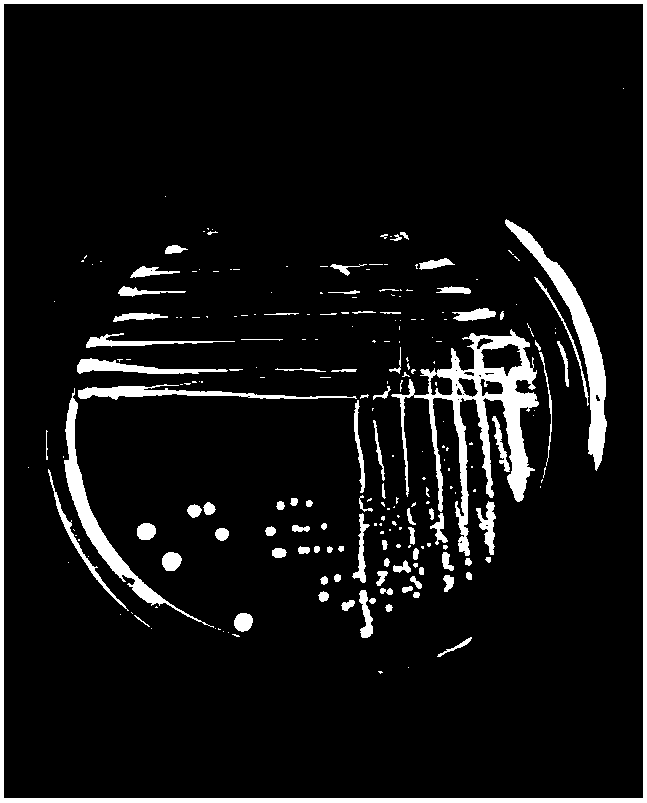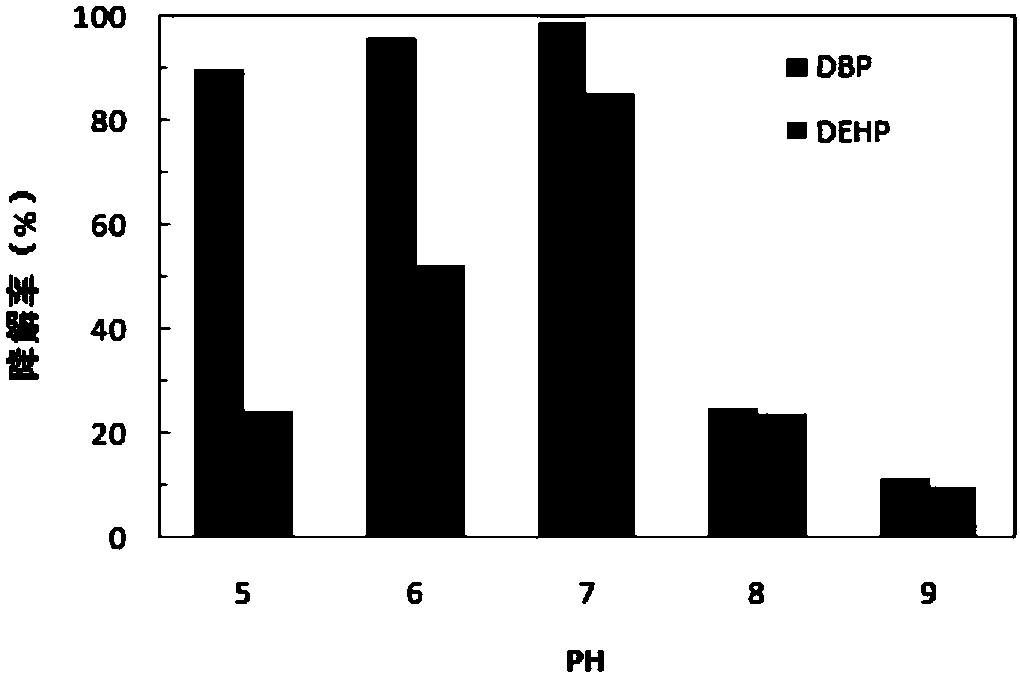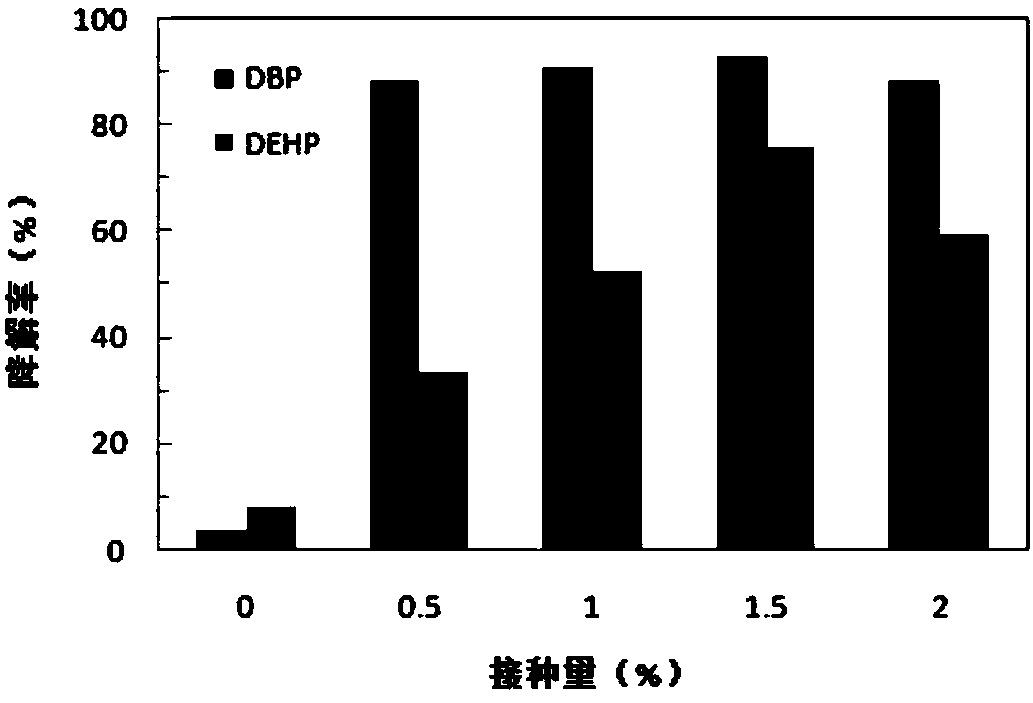Rhodococcus YC915 and application of adsorption bacterial agent of rhodococcus YC915 for degrading phthalate ester in soils
A technology of rhodococcus and bacteria agent, which is applied in the application field of rhodococcus YC915 and its adsorbed bacteria agent in degrading soil phthalate, which can solve the problems of phthalate pollution and achieve high degradation efficiency , simple operation, high-efficiency degradation effect
- Summary
- Abstract
- Description
- Claims
- Application Information
AI Technical Summary
Problems solved by technology
Method used
Image
Examples
Embodiment 1
[0034] Example 1 Screening and Identification of Phthalate Degrading Bacteria
[0035] (1) Screening of phthalate-degrading bacteria
[0036] A certain amount of soil samples were collected in vegetable greenhouses in the suburbs of Yinchuan City, and 10g of fresh soil samples were accurately weighed, added to a conical flask filled with 90mL of distilled water and 10mL of glass beads, and placed in a shaker at 30°C and 175rpm to vibrate and mix well. Set aside.
[0037] Take 1mL from the above mixed solution according to the inoculum size of 1%, add it to 100mL inorganic salt culture solution with an initial concentration of 100mg / L phthalate (both DBP and DEHP are 50mg / L), and place it on a shaker Shaking culture was carried out at 30°C and 175rpm in the dark for 7 days. Gradually increase the concentration of phthalates (including 200mg / L, 500 mg / L, 800mg / L, 1000mg / L, 1500mg / L and 2000mg / L) for each transfer, transfer once every seven days as an acclimatization cycle , c...
Embodiment 2
[0042] Example 2 Detection of Rhodococcus YC915's ability to degrade phthalates
[0043] Preparation of bacterial suspension: Pick smooth and complete colonies of Rhodococcus YC915, inoculate them into beef extract peptone liquid medium, and cultivate them in a shaking table at 28°C and 170r / min for 24 hours. After taking out the beef extract peptone liquid medium, put the culture medium in a sterilized centrifuge tube, and centrifuge at 4000r / min for 10min at room temperature to collect wet bacteria. Then wash three times with sterile physiological saline (0.9% NaCl solution). Finally, the bacterium was formulated into a bacterium suspension with physiological saline, so that the absorbance value OD=1 under the condition of wavelength λ=600nm.
[0044] Determination of residual amount of DBP / DEHP in DBP / DEHP inorganic salt medium: Add 30ml of ethyl acetate to 100ml of DBP / DEHP inorganic salt medium, shake for 30min, then transfer to a separatory funnel and shake for 5min to ...
Embodiment 3
[0061] The optimization of embodiment 3 adsorption bacteria preparation conditions
[0062] (1) Preparation of bacterial suspension: Inoculate strain YC915 into beef extract-peptone liquid medium, and culture at 28° C., 170 r / min for 24 hours. After taking out the liquid medium, divide the liquid into 50 mL sterile centrifuge tubes, and centrifuge at 4000 rpm for 10 min. After discarding the supernatant, resuspend with sterilized normal saline and centrifuge again. After washing twice, prepare the bacterial suspension with normal saline to make the OD 600 = 1.0.
[0063] (2) The preparation method of the adsorption bacteria agent: accurately weigh a certain amount of adsorption material biochar and pour it into a conical flask, add a certain volume of bacterial suspension with an OD600=1.0, shake it up and place it at different temperatures at a speed of 175r / h Min shaker shaking culture for a certain period of time, filtered and washed with sterile water until neutral, that...
PUM
 Login to View More
Login to View More Abstract
Description
Claims
Application Information
 Login to View More
Login to View More - R&D
- Intellectual Property
- Life Sciences
- Materials
- Tech Scout
- Unparalleled Data Quality
- Higher Quality Content
- 60% Fewer Hallucinations
Browse by: Latest US Patents, China's latest patents, Technical Efficacy Thesaurus, Application Domain, Technology Topic, Popular Technical Reports.
© 2025 PatSnap. All rights reserved.Legal|Privacy policy|Modern Slavery Act Transparency Statement|Sitemap|About US| Contact US: help@patsnap.com



